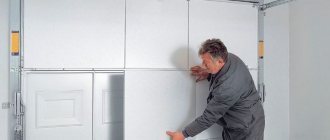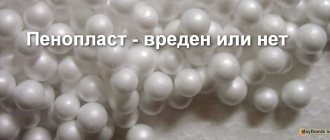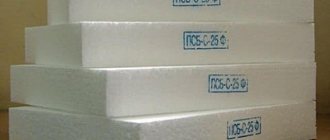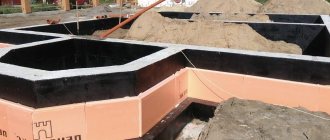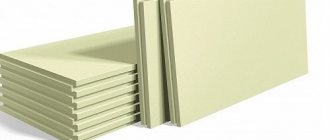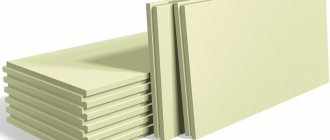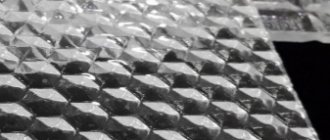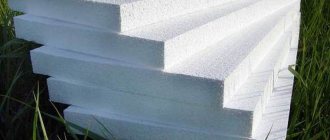Before gluing to a wooden, concrete or brick surface, as well as when deciding how to glue the foam together, you need to learn about the properties and characteristics of this material. Polystyrene foam, or, as it is otherwise called, expanded polystyrene, is formed as a result of foaming polymers. 98% of the material is gas, located in tiny cells with very thin walls.
Typically, foam boards are used as insulation for the walls of building facades and for finishing ceilings, walls, slopes indoors, in basements, on balconies and loggias. Expanded polystyrene can be glued to concrete, wood, metal, brick, plasterboard and gas silicate bases.
Main characteristics of polystyrene foam:
- excellent rigidity with low weight;
- long service life;
- excellent thermal insulation properties;
- resistance to moisture;
- expanded polystyrene with fire retardants does not burn;
- does not pollute the environment when disposed of after use;
- protects from wind if used outside the building;
- does not emit substances harmful to the human body; you can work with this material without protective equipment;
- does not dry out or shrink during long-term use, is resistant to temperature changes;
- It is easy to work with polystyrene foam - it is not difficult to cut, installation can be carried out using improvised means;
- mold fungi do not develop on it;
- inexpensive.
Using expanded polystyrene as an insulation material instead of wood, brick, concrete or mineral wool saves time, money and space indoors.
Polystyrene foam has disadvantages:
- breaks easily;
- has very poor breathability;
- is destroyed by the action of mixtures that include nitro varnish;
- deforms when solvent and ultraviolet rays hit the surface.
PPS as insulation
Both extruded and foamed polystyrene foam (both types of material are simply called polystyrene foam) are currently perhaps the most popular insulation for walls and ceilings in buildings for various purposes.
Extruded PPS is denser and stronger, so it is more appropriate to insulate buildings from the outside. It is better to use foam material to insulate internal surfaces that are not subject to mechanical stress. Sometimes external walls are also lined with this type of foam, but it must be covered with a protective cladding (wall insulation done in this way can be much more expensive).
Correct fastening of polystyrene foam to the facade using dowels.
The methods for attaching insulation to brick both outside and inside the house are almost the same. The main thing is that a material with suitable environmental safety characteristics is selected for them. The thickness of the purchased PPS slabs should depend on the thickness of the brickwork and climatic conditions in the region where the house is located.
Methods for fixing penoplex
The choice of a suitable method for installing insulation is determined by the quality and type of surface, as well as the level of load created by the material.
Attaching penoplex to the wall is done:
- With mastics.
- Dry mixtures.
- Glue.
- Dowels.
- Liquid nails.
- Self-tapping screws.
- Polyurethane foam.
Regardless of the chosen method, installation of insulation is carried out from the bottom up.
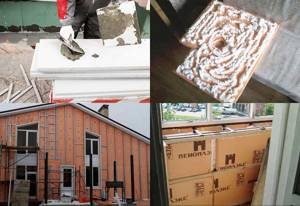
Polymer and bitumen mastics
Mastics are widely used for thermal insulation of plinths, foundations, external walls and balcony screens. They provide simple and safe installation on walls in the presence of unfavorable external factors.
Mastics are special viscous mixtures in tubes, ready for use. The tubes are installed in a construction gun, after which the mastic is evenly applied to the prepared insulation. Next, the material is mounted and pressed to the surface for a minute.
Modern mastics contain a small amount of petroleum products, so all installation work is carried out in compliance with safety rules and in well-ventilated areas.
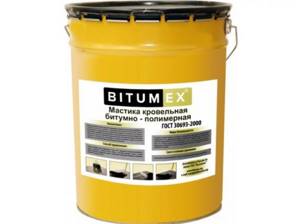
Dry mixes
Laying penoplex using dry cement-based mixtures is the most affordable option. Most often it is used to fix insulation to a concrete wall. The dry mixture is diluted according to the instructions to obtain a viscous solution. To simplify mixing, use a special attachment for an electric drill.
The finished solution is applied to the surface of the insulation with a notched trowel to uniformly fill the existing grooves. Next, the insulation is installed in the same way as the previous method.

Adhesive compositions
Penoplex can be glued together using special adhesives presented in the form of foam. Glue is used in the same way as polyurethane foam. The high adhesion of the material allows you to fix penoplex on smooth concrete and stone surfaces.
The composition is applied around the perimeter of the insulation with a construction gun for sealant or polyurethane foam. Next, it is pressed against the surface to be treated for 40 seconds. It will take at least half an hour for the material to fully set.
After two hours, work on finishing the surfaces is carried out.

Disc-shaped dowels
A fastening element with a wide head, which is used for large areas of thermal insulation and for uneven surfaces, such as a brick wall.
How to attach polystyrene foam to the wall - difficult cases
Sheathing concrete walls with foam plastic is perhaps the easiest task. But what to do if you need to fix the plates on a metal surface? Oddly enough, you can get by with inexpensive products that you have on hand. For example, PVA glue. If the requirements for strength are not the highest, then this method is perfect. In addition to glue, you will need burlap. It is properly impregnated with PVA composition and attached to the base surface. And only then they glue the slabs onto the burlap, generously lubricated with the same glue.
However, if we are talking about gluing on the outside of a building or in places where adhesive strength is important, it is better to purchase a special polyurethane adhesive.
Its only drawback is that it takes a long time to dry. Therefore, the slabs can slide under their own weight if they are not supported with sheets of plywood or a board of the required size. To avoid having to wait and prop up, you can use liquid nails - this popular adhesive does not react with foam. True, the quality of adhesion will still be lower than in the case of polyurethane glue.
But there is still an option to use the compounds together - liquid nails provide speed of work (no need to wait, no need to make supports), and the polyurethane component will give the structure the necessary strength. But the costs will be significantly higher. Another option is polyurethane foam. Indeed, this popular sealant has excellent adhesive properties - you could probably see this when trying to wipe off the foam stuck to your hands.
In addition, disposable cans do not require the purchase of a special gun for squeezing out foam - such a tool is a must when working with polyurethane glue. Polyurethane foam very often remains unused after installing windows and doors, so if you need to secure polystyrene foam, you can easily use this sealant. Just keep in mind that it should be applied in small quantities in five places. There should not be an excess of foam, otherwise during the hardening process it will expand and deform the slabs.
Preparatory work
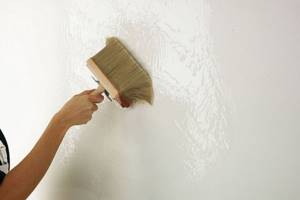
Before gluing foam to concrete or other material, the surface should be cleaned. To do this, it is enough to remove dust and dirt. You can use a spray bottle as an assistant.
If such equipment is not available, then a regular metal brush is used. Its pile will thoroughly clean the surface from any type of dirt. In the case where the surface has an uneven texture, you will initially need to level it.
All types of unevenness that have a difference of more than 1 cm will lead to the breakdown of the foam.
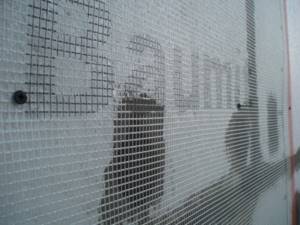
After cleaning and leveling, you need to cover the wall with primer; it is better to use a brush, which will additionally clean the surface from dust and dirt. Next, you need to prepare a mesh; it should be glued around the window and door openings. The mesh is applied to the wall and simply nailed with staples using a construction stapler. The mesh can be secured using glue.
The mesh is sold in rolls, so for more convenient use you need to cut it into strips of about 40-50 cm. The mesh is glued to the walls so that at least 15 cm of it is under the insulation. The remainder can be wrapped and after pasting the walls with insulation, apply it over the foam.

Construction mixer
In addition to preparing the walls themselves, you also need to prepare the tools. To do this you will need:
- A mixer or drill with an attachment that will be used to mix glue and putty.
- A spatula that is used for adhesive composition.
- A small spatula that will be used to conveniently remove remaining glue.
- Wide spatula for leveling walls.
- Perforator for installing fungi. A 10 mm drill is used.
- Container for solution.
- Primer brush.
After completing the basic preparatory steps, you can begin installing the foam on the walls. The question often arises of how to glue foam to the wall. For these purposes, plaster or special glue can be used. It is these two application methods that will be presented below.
Glue mounting
What glue is best for gluing foam? If we are talking about gluing the sheets themselves to each other, then any composition will do. This can be a dry type or a wet type, the main thing is that they do not contain a solvent.
When choosing glue, you should clearly understand where the insulation is being carried out. If this is internal work, then there is not much difference in the glue. If the facade is insulated, then it will be necessary to use a special class of glue that will be resistant to the influences of nature. The glue is diluted according to the instructions on the package and applied in the same way as plaster.
The concrete base itself is cold; for such a surface it is better to use special polyurethane foam instead of glue. It is sold in cylinders and is easy to work with. In addition, foam can glue the material to a metal surface.
Although the composition adheres the insulation very well to any surface, you should be careful and ensure that the foam does not harden in the container. To save money, it is better to use flushing, which does not allow the remaining foam in the cylinder to dry out when work is suspended for a certain time. For more information about the best way to glue foam plastic, watch this video:
That's all the information you need on how to glue foam plastic and how to carry out installation work correctly. For the highest quality adhesion of the insulation, use the tips given in the article, then the house will save not only heat, but also money. As you can see, the work is simple and can be done independently in just a few days.
Why Kreisel?
Professional builders are well aware of the Kreisel brand, because it is one of the largest manufacturers of building mixtures in Europe and the world. The company is part of the FIXIT GRUPPE group, which unites 44 factories in twenty countries.
Kreisel products have been represented on the Russian market since 2004. The brand produces a wide range of construction and finishing materials: plasters, putties, paints, masonry and repair mixtures. Kreisel glue deserves special attention: the manufacturer offers a line of high-quality dry mixtures for gluing façade foam plastic and mineral wool.
All Kreisel brand products are developed in accordance with modern European standards. The materials have a high-quality, balanced composition, are easy to use, and their use guarantees reliable results.
Which is better?
In order to decide which adhesive composition to use, the following features should be taken into account:
- It is recommended to choose proven products from manufacturers that have proven themselves on the positive side in the construction market.
- Be sure to pay attention to the expiration date.
- Quality material will never be cheap.
- Read the instructions carefully. The glue can be used not only for external, but also for internal work.
- It is strictly forbidden to purchase products that contain solvents.
- Read the instructions carefully.
- to the tree
- to concrete
- to the brick wall
- to iron and metal
- to plastic
A huge variety of compositions allows you to reliably and firmly glue foam to various materials:
To glue foam to metal or concrete, it is recommended to use polyurethane foam glue . For other types of surfaces, you can use both polyurethane foam and other types of glue such as “Master” or “Dragon”.
Characteristics, advantages and disadvantages of the material

Standard sheets that are used for insulation are 1x1 m or 0.5x1 m. In addition, the material can be of different densities, which have values of 15, 25 and 40. As a rule, the higher the density, the better, but the purchasing price will be higher. If we take the average option, more precisely, 25 density, then the thickness of the material will be from 5 cm, this type is used for outdoor work.
If 15 density is used, then the foam is suitable for interior work and can be used for wood or concrete. 40 density is used as a floor covering for floor insulation. This material is of very high density, due to which it is not afraid of the loads that will be received. This foam is not pressed or deformed.
Polystyrene foam is truly a universal material, but it has both pros and cons. All of them are shown in the table:
| № | Advantages | Flaws |
| 1 | Light weight due to the composition, where 98% is air or gas. | For different materials that foam is applied to, there are different gluing methods that need to be taken into account. |
| 2 | Easy to process and install. | After gluing, the foam should be additionally covered with a protective layer. |
| 3 | High resistance to sunlight and temperature changes. | Almost no air passes through. |
| 4 | High heat capacity. | It can be destroyed by some types of paints and adhesives, so you should clarify what you are using to glue the foam and what needs to be applied to it after finishing the work. |
Since the walls of the house will not breathe after insulation with polystyrene foam, you need to carefully consider and make ventilation.
Polyurethane foam
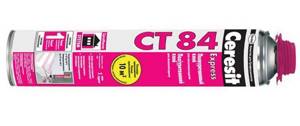
This is not a good way to glue foam. Everything is connected with some disadvantages of this option:
- The solution expands greatly after application, and this can cause the appearance of uneven insulation and voids.
- The composition may contain components that destroy the structure of the foam.
- The elements will have to be kept pressed to the base for a long time for reliable fixation.
- Large consumption of substances.
But if such disadvantages do not frighten you and you still choose polystyrene foam to glue the foam to the base, then as a result the slab is securely glued, especially on a stone wall.
